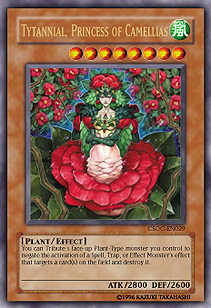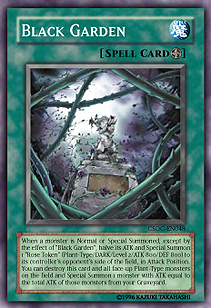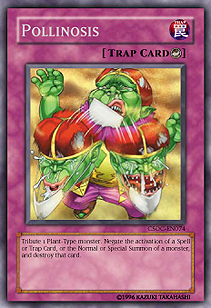 Rogue decks enter lengthy tournaments these days with one goal: eliminate all TeleDAD decks. The idea is that if you can beat TeleDAD, you can advance far into the tournament. This is how all rogue strategies begin. Whether or not they are successful depends on how lucky their pairings are. Someone who faced the ideal deck all day will do well. When I played Machines at Nationals in 2007,
Rogue decks enter lengthy tournaments these days with one goal: eliminate all TeleDAD decks. The idea is that if you can beat TeleDAD, you can advance far into the tournament. This is how all rogue strategies begin. Whether or not they are successful depends on how lucky their pairings are. Someone who faced the ideal deck all day will do well. When I played Machines at Nationals in 2007,
I faced nothing but Destiny-Hero-themed decks all day. Since I was entirely prepared for that deck, I was successful nearly every time I faced one. The deck was an instant hit and was tested by everyone planning to attend U.S. Nationals. Eventually Fili Luna would make the final build that capitalized on the strengths he saw in testing and could take on any deck at the tournament.
The success of Machines hinged on one card: Trap Dustshoot. Dustshoot broke up both the Monarch and the Destiny Hero combos, leaving dead copies of Destiny Draw and Soul Exchange in the opponent’s hand. I was hurting pretty badly in games where I didn’t draw Dustshoot, but because the deck had so much draw power, my tournament success didn’t suffer. Winning really was as easy as flipping Trap Dustshoot and then playing as aggressively as I could.
Trying to stop your opponents from special summoning monsters in a tournament just isn’t going to happen. Enough people are going to summon their Synchro monsters before you can negate them and there will be times where you draw no negation at all. TeleDAD doesn’t stop the opponent from Synchro summoning and it’s the most successful deck. That’s because it controls what the opponent can and can’t special summon, and takes advantage of what’s left.
Jerome McHale has found another way to do that: the secret is Black Garden. Here’s what brought him to within a single win of topping at Shonen Jump Championship Detroit:
Monsters: 19
2 Tytannial, Princess of Camellias
 3 Lonefire Blossom
3 Lonefire Blossom
3 Botanical Lion
2 Lord Poison
2 Nettles
1 Gigantic Cephalotus
3 Cyber Valley
1 Sangan
1 Card Trooper
1 Gorz the Emissary of Darkness
Spells: 11
3 Black Garden
2 Terraforming
3 Mark of the Rose
2 Miracle Fertilizer
1 Monster Reborn
Traps: 11
3 Phoenix Wing Wind Blast
3 Solemn Judgment
3 Pollinosis
1 Torrential Tribute
1 Mirror Force
All you need to do is read Black Garden to see how the deck destroys TeleDAD. Black Garden instantly and permanently halves the ATK of any monster that is normal summoned or special summoned. That means every Synchro monster is going to be halved, Dark Armed Dragon is going to be halved, and even if you destroy the Garden afterward, the monsters’ ATKs are still depleted. Garden also special summons a Plant-type Token monster, placing it on the opponent’s side of the field whenever he or she normal- or special summons something.
 If that hasn’t sunk in quite yet, think a minute about how TeleDAD wins most of its games. Special summon Destiny Hero - Malicious, two copies of Krebons, and Dark Armed Dragon. Then destroy the opponent’s field and attack for over 8000 damage. You can’t do that if I have Black Garden out. I’ll have a field full of tokens that you’ll have to attack through, and your monsters have only half their normal ATK. Even if you could clear my field of the Tokens, your monsters couldn’t attack for game, and since you can’t do that either, I probably won’t be taking any more than 1000 damage this turn.
If that hasn’t sunk in quite yet, think a minute about how TeleDAD wins most of its games. Special summon Destiny Hero - Malicious, two copies of Krebons, and Dark Armed Dragon. Then destroy the opponent’s field and attack for over 8000 damage. You can’t do that if I have Black Garden out. I’ll have a field full of tokens that you’ll have to attack through, and your monsters have only half their normal ATK. Even if you could clear my field of the Tokens, your monsters couldn’t attack for game, and since you can’t do that either, I probably won’t be taking any more than 1000 damage this turn.
That’s why the card cracks the metagame in half. Usually if I’m able to stop one thing with Solemn Judgment, you’ll just run me over with your other threats. If I stop the next thing I’m even easier to finish off, and you can probably win with your last card. It’s the reason you can’t just throw out Stardust Dragon and Solemn Judgment and expect to win. But with Black Garden and Solemn Judgment, you can. Even if you spend a Solemn on Heavy Storm, your opponent can’t beat you with a wave of Synchro summons and Dark Armed Dragon! Black Garden stops them single-handedly.
So the game really becomes one of protecting the Garden. Most players want to destroy the Garden with monster effects. That’s how we deal with problems these days: Snipe Hunter, Breaker the Magical Warrior, Dark Armed Dragon, or Caius the Shadow Monarch. Deal with cards by using monster effects and protect them with spells and traps: that’s what we’d like to do. But the Plant deck stops that from happening entirely. In addition to three copies of Solemn are three copies of Pollinosis: a Solemn Judgment that’s turned online as soon as your opponent summons a monster and you get a Token to tribute.
That’s fine, though, since you rarely want Solemn to be the first monster your opponent plays. The only time you’ll want to do this is against Breaker the Magical Warrior and Snipe Hunter, in which case you just need another Plant monster (and this deck plays plenty of them). But back to what you want to Solemn: Stardust Dragon, Dark Armed Dragon, Caius the Shadow Monarch, and Crush Card Virus all usually follow the summon of another monster. That means that as long as you have Garden, you’ll have the necessary (and free) tribute for Pollinosis.
But as good as six Solemns are, eight would be even better. So tack on two copies of Tytannial, Princess of Camellias. Tytannial can only stop effects that target, but once again that’s pretty much everything you want to stop: Phoenix Wing Wind Blast, Mystical Space Typhoon, Snipe Hunter, Dark Armed Dragon, Brain Control, Book of Moon, and Breaker the Magical Warrior. I don’t think anything has been able to negate all these cards before without costing half your life points. Tytannial costs you a Plant on the field, which would be a problem if you didn’t always have one thanks to Black Garden and your own special summon cards.
 The fact that Tytannial is a two-tribute monster can be bypassed by all the special summon cards and the incredibly ridiculous effect of Lonefire Blossom. Lonefire can pull Tytannial from the deck, meaning any Lonefire or Sangan can eventually be a 2800 ATK, negation-happy Plant Princess. And since it’s so easy, you can do that before playing the Garden, leaving yourself with a 2800 ATK monster that can’t be run over in battle except by something with over 5600 original ATK points. Good luck.
The fact that Tytannial is a two-tribute monster can be bypassed by all the special summon cards and the incredibly ridiculous effect of Lonefire Blossom. Lonefire can pull Tytannial from the deck, meaning any Lonefire or Sangan can eventually be a 2800 ATK, negation-happy Plant Princess. And since it’s so easy, you can do that before playing the Garden, leaving yourself with a 2800 ATK monster that can’t be run over in battle except by something with over 5600 original ATK points. Good luck.
Of course there’s a way to get around Garden’s ATK-halving effect: you simply need to flip summon the monster you want to use. That’s not really any good for TeleDAD players. They can’t afford to put Krebons or Snipe Hunter face down first. Speaking of Krebons, you can’t even play it to wall up. Summoning the Psychic gives your opponent a monster with enough ATK to force you to pay 800 life points a turn on its own. All you’ve really done is given me an out to attack through a field of tokens. There’s little nasty synergies like that everywhere in this deck.
But with that in mind, do you know who can flip summon monsters? Check Botanical Lion again. It’s not simply a filler monster: it starts with 1900 ATK, it can’t be taken by Brain Control or Enemy Controller, and it gets bigger every time more Plants hit your field. With Black Garden special summoning Plant tokens to both players’ fields in attack mode, that’s a legitimate concern for the opponent. I can just keep summoning monsters to give you Plants to beat up with the Lion, while your own summons make my Lion bigger! The best part is that Botanical Lion has 2000 DEF, meaning it’s hard enough to get by normally and impossible to get through when the Garden is in play.
I haven’t even talked about Nettles yet. Just think about all the things you can do with this card. The Tokens you get are level 2 so Nettles makes any level-6 Synchro with two of them, and turns into a level-8 Synchro with a trio. A lot of the time players just try to turtle up against this deck, and you’ll rely on being able to use Nettles for Red Dragon Archfiend more than you think.
Jerome was pretty successful considering how difficult the tournament was for him in Detroit. This is just the first build in what is sure to become a competitive anti-meta strategy in the upcoming months.
—Matt Peddle